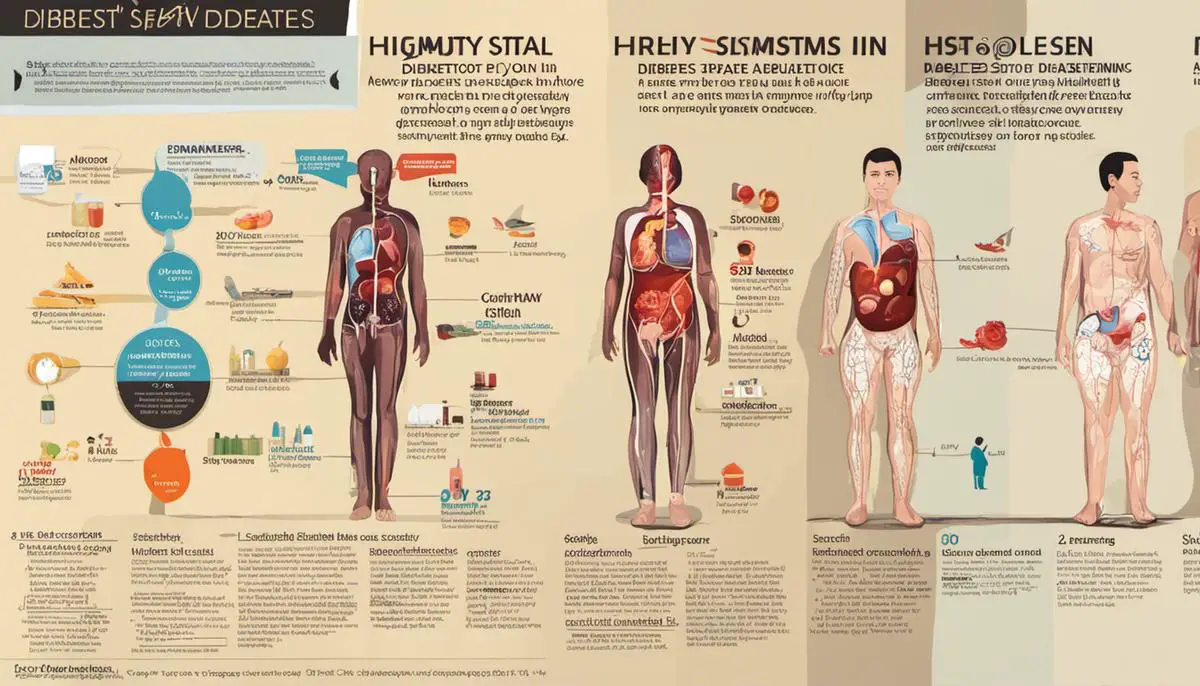Diabetes is a complex, pervasive health challenge that remains a significant public health concern worldwide. The disease, characterized by elevated blood sugar levels, can manifest in different forms, each type bringing with it unique symptoms and triggers. While diabetes is non-discriminatory and can affect any individual, it is crucial to consider the role gender may play in both its prevalence and management. This deep-dive explores the risk factors, management, and outcomes of diabetes in females and males separately, indicating a need for customized approaches to prevention and care.
Understanding Diabetes
Understanding Diabetes: Definition, Types, Symptoms, and Causes
Diabetes is a chronic disease that affects the body’s ability to process blood glucose, also known as blood sugar. This impairment occurs due to either the pancreas not producing enough insulin or the body not using insulin effectively, resulting in high blood sugar levels. Primarily, it is classified into two types: Type 1 and Type 2 diabetes.
Type 1 diabetes, previously known as juvenile diabetes, is an autoimmune condition where the body’s immune system attacks and destroys insulin-producing cells in the pancreas. This makes the body insulin deficient, causing high blood sugar levels that can lead to serious health problems if not managed.
Type 2 diabetes, the most common form, occurs when the body becomes resistant to insulin or the pancreas is unable to produce enough insulin. The cause- reasons can often be attributed to lifestyle factors such as obesity and lack of physical activity, although genetics and other risk factors also play significant roles.
Symptoms of both types of diabetes are similar, often including increased thirst and hunger, frequent urination, unexplained weight loss, fatigue, and blurry vision. If left untreated, this can lead to a host of complications ranging from heart diseases, stroke, kidney disease, and eye problems to nerve damage.
Global Prevalence of Diabetes and its Implications
The rising prevalence of diabetes worldwide is a significant cause for worry. According to the International Diabetes Federation (IDF), approximately 537 million adults were living with diabetes in 2021, and this number is projected to rise to 643 million by 2030. This escalating trend is driven by a combination of factors like an aging population, changes in dietary habits, increased urbanization, and sedentary lifestyles.
The condition imposes a heavy economic burden on individuals and healthcare systems worldwide. In 2021, a staggering $966 billion was spent on managing diabetes, nearly 13% of the total global health expenditure. It also leads to substantial productivity loss, given its high prevalence among the working-age population and debilitating complications when poorly managed.
Understanding Diabetes Prevalence Among Genders: Females vs Males
When we look at the worldwide rates of diabetes, the numbers reveal that its prevalence is almost equal among both genders. According to the International Diabetes Federation (IDF), the global diabetes count for 2021 stood at approximately 268 million males and 269 million females. Nonetheless, while the numbers might imply an equal susceptibility for both genders, the consequences of the disease and methods of management can differ significantly between men and women.
Women living with diabetes, notably Type 2, encounter unique challenges not typically experienced by men. They face a higher risk for heart diseases, which are the predominant cause of death among people with diabetes. Moreover, women with diabetes often struggle with keeping blood glucose levels in check, leading to an increased likelihood of complications such as eye and kidney diseases.
Factors like hormonal fluctuations during the menstrual cycle can create variances in blood glucose levels, complicating the management of diabetes. Furthermore, gestational diabetes, which manifests during pregnancy, can pose substantial health risks to both the mother and offspring.
On the flip side, men diagnosed with diabetes are more likely to have lower testosterone levels, resulting in issues such as erectile dysfunction, loss of muscle mass, and depression.
Studies suggest that men tend to seek medical care less often than women, which could contribute to delayed diagnosis and grave complications arising from diabetes. Additionally, men face a higher risk of amputations related to diabetes.
In summary, differences in gender when it comes to diabetes prevalence as well as how the disease is experienced and managed necessitate a gender-focused approach to prevention, diagnosis, and treatment.

The Diabetes Risk in Females
The Role of Gender in Diabetes Risk Factors: Women’s Perspective
Moving further into the discussion, we find that certain risk factors for diabetes are influenced significantly by gender. There’s evidence suggesting that women could be slightly more predisposed to diabetes than men due to various biological and lifestyle components that escalate their risk.
Hormonal Changes and Diabetes Risk in Women
Hormone fluctuations experienced by women through various stages of life, including menstruation, pregnancy, and menopause, can influence blood glucose levels. For instance, during menstruation, hormonal changes can cause fluctuations in blood sugar, making management difficult in women with diabetes.
During pregnancy, the body undergoes significant changes, including insulin resistance. This condition can lead to gestational diabetes, a form of diabetes that affects pregnant women and is linked to an increased risk of type 2 diabetes later in life.
Menopause, another critical life event for women, can impact the body’s ability to use insulin effectively. Estrogen, a hormone that helps regulate blood sugar, decreases during menopause, potentially promoting insulin resistance and leading to higher blood glucose levels.
Polycystic Ovary Syndrome and Diabetes
Polycystic ovary syndrome (PCOS), a condition that affects women’s ovarian function, has been linked to the development of Type 2 diabetes. Women with PCOS often experience a high level of insulin resistance, making them more susceptible to developing diabetes.
Insulin Processing in Females
Further adding to the propensity of diabetes in women, research suggests that women’s bodies may process insulin differently than men’s. Women typically need to produce more insulin than men to process the same amount of blood glucose, which can place additional strain on the insulin-producing cells in the pancreas and, over time, can lead to diabetes.
Lifestyle Factors Contributing to Diabetes in Women
Lifestyle factors, including diet and physical inactivity, also contribute significantly to diabetes risk in women. Obese and overweight women are particularly at risk. The American Diabetes Association has found that women are more likely than men to be obese, which significantly increases the risk of Type 2 diabetes. Furthermore, studies show that physical inactivity is more common in women, further raising the risk of obesity and diabetes.
Comparative Risk of Diabetes in Males
However, it should be noted that men are not immune to the risk of diabetes. Male-specific factors such as low testosterone levels have been linked to insulin resistance, potentially increasing the risk of developing diabetes. Additionally, lifestyle factors like obesity, low physical activity, and unhealthy diet carry similar risks for diabetes development in men.
It’s important to note that anyone, regardless of gender, can develop diabetes. However, studies suggest that specific biological and lifestyle factors, such as hormonal changes and conditions like Polycystic Ovary Syndrome (PCOS), may make women somewhat more susceptible to the disease. That’s not to say men are in the clear – both genders should prioritize preventative care, a balanced lifestyle, and regular medical consultations to manage their risk and keep the disease in check should it develop.

The Diabetes Risk in Males
Diabetes Incidence Among Men and Women
Though both men and women can develop diabetes, statistical data does show variance in its prevalence among both genders. The Centers for Disease Control and Prevention (CDC) stated that, in 2018, roughly 14.3 million men and 13.4 million women over the age of 18 were diagnosed with diabetes in the United States. However, it’s important to mention that the likelihood of being diagnosed can be influenced by several factors including age, ethnicity, and Body Mass Index (BMI).
Unique Risk Factors Contributing to Diabetes in Males
Several factors contribute to diabetes risk in men. Testosterone levels play a significant role in glucose metabolism, with low testosterone levels linked to increased risk of type 2 diabetes in men. Research indicates that low testosterone affects the body’s response to insulin, the hormone that controls blood sugar levels, thereby increasing the risk of developing diabetes.
Another factor is the distribution of fat in the body. Men are more likely to store excess body fat in the abdomen, a notorious risk factor for type 2 diabetes. Also, men are often diagnosed with diabetes at lower BMI levels than women, which might be due to their tendency to carry excess weight in the abdominal area.
Lifestyle habits also play a critical role in diabetes development. Studies suggest that men are often less likely than women to engage in regular physical exercise and are more likely to have unhealthy diets, contributing to a higher risk of diabetes.
How Men’s Bodies Process Insulin Differently
The way men’s bodies process insulin differs to a certain extent from women’s. When the body doesn’t use insulin effectively, it leads to insulin resistance, a key risk factor for developing type 2 diabetes.
In comparison to women, men are usually more insulin resistant, a condition exacerbated by excess abdominal fat. Insulin resistance might develop earlier in men and at lower levels of abdominal obesity than in women. This difference in insulin sensitivity could partially explain why men, particularly those with excess abdominal fat, tend to develop diabetes at lower BMI levels compared to women.
Understanding the Diabetes Risk in Females
On the other hand, women also have unique risk factors. For instance, conditions such as polycystic ovary syndrome (PCOS), gestational diabetes, and menopause can significantly increase a woman’s risk of developing type 2 diabetes. These conditions are associated with insulin resistance and hormonal changes that negatively impact how the body processes glucose.
It’s essential to consider that the key risk factors for diabetes development, including obesity, a sedentary lifestyle, an unhealthy diet, and a family history of diabetes, are not exclusive to one gender. Both men and women are equally susceptible to these risks.

Gender Differences in Diabetes Management and Outcomes
Comparing the Prevalence and Risk of Diabetes in Men and Women
Data from the Centers for Disease Control and Prevention (CDC) highlight some differences in diabetes prevalence among men and women. As of 2020, it appears that adult men are slightly more likely to develop diabetes, with the rate being around 14.3%, compared to 13.2% for adult women. However, these numbers are relatively close and can show differences over time, signifying that the gap between genders is not substantial.
Biological Factors Impacting Diabetes Risk
Biological differences between men and women may play a role in diabetes risk. For instance, certain hormonal changes during pregnancy can lead to gestational diabetes, a temporary form of diabetes that only affects females. Moreover, polycystic ovary syndrome (PCOS), a condition that affects women’s hormone levels and can cause insulin resistance, increases the risk of type 2 diabetes.
Additionally, male vulnerability can be attributed to some factors. Men are more likely to carry weight around their middles, which is a risk factor for diabetes. Also, men are more prone to develop diabetes at a lower body mass index (BMI) than women.
Gender Differences In Diabetes Symptoms
Notably, men and women may experience different symptoms when they develop diabetes. Men often report more traditional symptoms, such as increased thirst and frequent urination. Women, on the other hand, might experience symptoms such as urinary infections and dry, itchy skin. Men may also develop diabetes-related complications like heart disease, at an earlier stage than women.
Treatment Response and Health Outcomes
The effectiveness of diabetes treatments may also vary by gender. Some studies suggest that women might be less responsive to insulin treatment than men. Additionally, women with diabetes may face unique health outcomes, such as a higher risk of heart disease compared to men with diabetes. Certain complications, such as diabetic retinopathy and nephropathy, are also reported to be higher in men than in women.
In management, women with diabetes tend to have poorer glycemic control and worse outcomes, which could be linked to hormones, biological differences, and behaviors related to health care utilization.
Conclusively
It’s paramount each gender understands their unique risks and symptoms, seeking timely treatment and proper management. It’s also crucial for healthcare providers to consider these differences when designing treatment plans. Despite the slight male prevalence, anyone can develop diabetes, regardless of their gender, and early diagnosis and management is vital.

Understanding the differences in diabetes risk, management, and outcomes between males and females is vital for improving public health strategies. Gender-specific analysis reveals the distinct risk factors that come into play, pointing towards the need for personalized prevention and treatment protocols. While hormones, obesity distribution, and lifestyle factors play crucial roles, there’s still much to understand about how each gender’s body processes sugar. The deep interconnectedness of gender with the prevalence and experience of diabetes shatters the one-size-fits-all approach to disease management, urging medical professionals and researchers to continue exploring individual-centered strategies for tackling diabetes.
